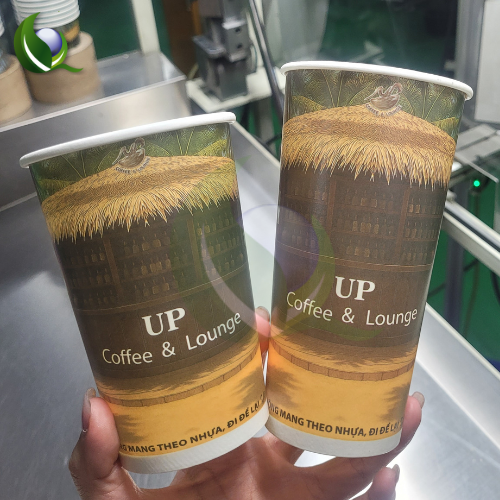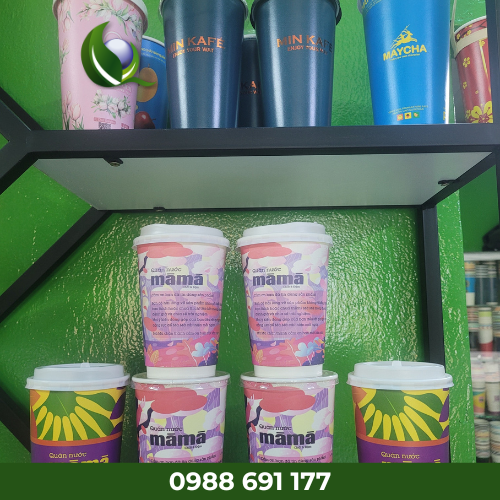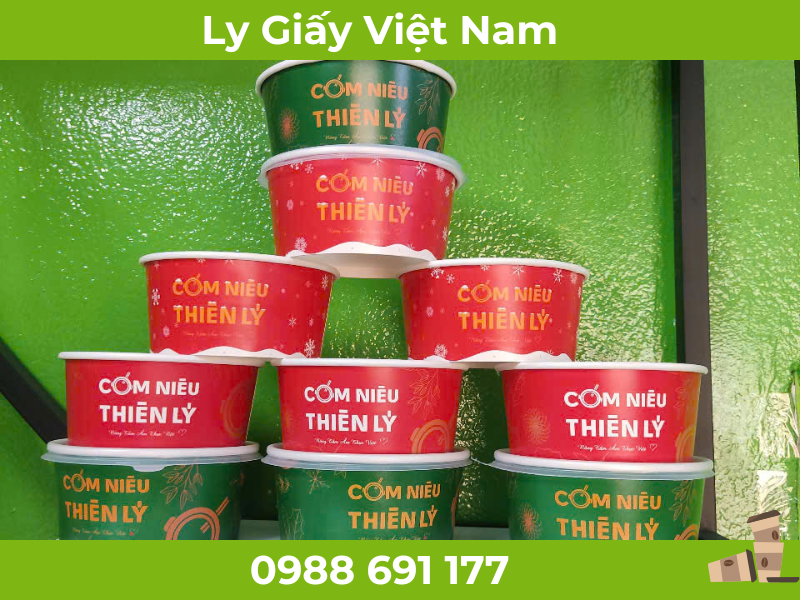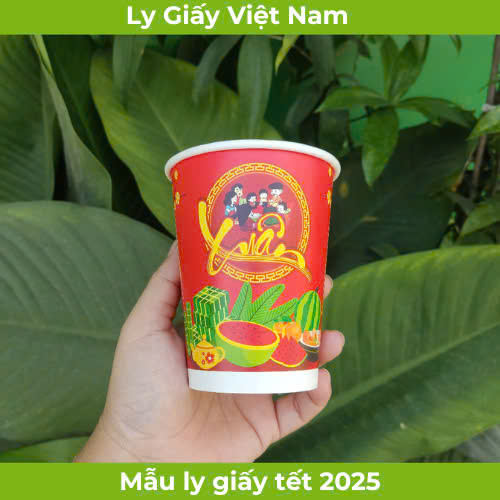



The process of producing paper cups that meet food safety standards is a series of complex stages, requiring precision and strict compliance with food safety regulations
The process of producing paper cups that meet food safety standards is a series of complex stages, requiring precision and strict compliance with food safety regulations, in order to bring safe, quality paper cups to users. Understanding the process of making safe paper cups helps consumers confidently choose and businesses have a sustainable production orientation.
The solution here is not only to create a convenient paper cup, but also to ensure public health and brand reputation. Understanding how to produce safe paper cups and methods of manufacturing food-friendly paper cups is the key to the development of this industry, while meeting the increasing demand for safe and convenient products. Factors such as PO paper materials, PLA paper and a standard paper cup production system play a key role.
In the modern consumer era, paper cups have become an indispensable item in daily life, from bustling coffee shops, trendy milk tea shops to corporate offices or community events. Convenience, aesthetics and high customizability have helped paper cups quickly dominate the market. However, along with popularity are increasing concerns about the quality and safety of this product for consumers' health. Cheap paper cups, of unknown origin, produced according to loose processes can potentially pose many risks from toxic chemicals in raw materials, poor quality ink or unsanitary production processes.
According to an informal survey at the end of 2023, more than 60% of consumers surveyed expressed special concern about safety when choosing paper cups, but lacked information to distinguish standard products. This shows an urgent need for transparency in the production process of paper cups that meet food safety standards. A standard process is not only a commitment to product quality but also a foundation for building solid trust in customers and affirming the reputation of the manufacturer. Standards such as ISO 22000, HACCP or specific regulations of the Vietnamese Ministry of Health on food contact materials are important guidelines.
At Ly Giay Viet Nam, we understand that each paper cup delivered to consumers is not just a product but also a peace of mind and trust. Therefore, investing in a paper cup production process that meets advanced food safety standards, with strict control from input materials to final products is our top priority.
To create paper cups that are not only beautiful, convenient but more importantly, absolutely safe for the health of users, a strictly controlled production process that complies with international standards is a prerequisite. Vietnam Paper Cups is proud to apply a modern, transparent production process, ensuring that each product is of the highest quality. Let's go into each stage to better understand the technique of making safe paper cups.
The Importance and Core Standards in the Food Safety Paper Cup Production Process
Paper cups come into direct contact with food and beverages, so any negligence in production can lead to the risk of toxic chemical contamination, negatively affecting the health of consumers. Digestive-related diseases, even the risk of cancer in the long term, can originate from the use of substandard products. Therefore, the application of food safety standards is not only a legal responsibility but also a matter of business ethics.

Understanding and applying these standards not only helps Vietnam Paper Cups create safe products but also helps consumers and business partners have a basis for choice and trust. We are committed to constantly updating the latest regulations and technologies to always be at the forefront of the field of food safety paper cup production.
Advanced Material Technology in Safe Paper Cup Production – The Foundation for Superior Quality
The quality of the finished paper cup depends largely on the input materials. A paper cup production process that meets food safety standards begins with the strict selection and control of the main materials: base paper, coating layer and printing ink.
Background Paper:
Coating Layer: The coating layer acts as a waterproof layer, keeping the cup from becoming soft when containing drinks.
Polyethylene (PE): This is the most common plastic used to coat paper cups. PE is food-safe and has good waterproofing properties. Paper cups can be coated with one layer of PE (inside, for hot drinks) or two layers of PE (both inside and outside, for cold drinks to prevent condensation on the outside). Vietnamese Paper Cups use virgin PE resin, not recycled plastic for the food contact layer. The thickness of the PE coating is usually from 10-18 micrometers.
Printing Ink:
Investment in high-quality raw materials and advanced material technology is a solid stepping stone, ensuring that the food safety standard paper cup production process of Ly Giay Viet Nam always brings superior products.
Detailed Steps In The Production Process Of Paper Cups That Meet Food Safety Standards At Vietnam Paper Cups
After ensuring quality input materials, the paper cup production process at Ly Giay Viet Nam is implemented through modern machinery and strictly controlled stages.
Step 1: Receiving and Checking Input Materials
Step 2: Coating PE/PLA on Paper Surface
Step 3: Print the Pattern on Paper
Step 4: Die-cutting Paper into Cup Blanks:
Step 5: Create the Cup Shape
This is the most important step, turning flat paper blanks into finished cups.

Summary Table of Basic Technical Parameters in Paper Cup Production (Reference)
| Category | Specification/Standard (Estimated - May 2025) | Unit | Note |
|---|---|---|---|
| Paper Material | |||
| Pulp | 100% virgin pulp, FSC certified preferred | % | Not recycled |
| Grammage (GSM) | 170 - 350 (depending on cup type) | g/m² | Hot cups typically use higher GSM |
| Moisture Content | 6 - 8 | % | |
| Coating Layer | |||
| Type | Virgin PE / PLA | - | Gradually increasing PLA ratio |
| Thickness (single layer) | 10 - 18 | micron | |
| Printing Ink | |||
| Type | Water-based, soy-based | - | Food-safe |
| Lead (Pb) Content | 50 (stricter than national standards) | ppm | |
| Cadmium (Cd) Content | 5 (stricter than national standards) | ppm | |
| Forming Process | |||
| Side Sealing Temp. (PE) | 150 - 250 | °C | |
| Bottom Sealing Temp. (PE) | 180 - 280 | °C | |
| Avg. Machine Speed | 120 - 180 | cups/min | Depends on machine and cup size |
| Quality Control | |||
| Allowable Defect Rate | 0.5 | % | For critical defects (leakage, deformation) |
| Leakage Test Frequency | 0.5 - 1% of each lot or continuous by auto machine | - | |
| Total Microbial Count | 1000 (referencing some countries' standards) | CFU/cup | Periodic inspection |
Note: The above figures are for reference only and may change depending on the specific technology and standards of Vietnam Paper Cup at each time.
Step 6: Finished Product Quality Control
This is the key stage to ensure that no defective products are released to the market.
Visual Inspection:
QC staff or automated camera systems inspect 100% of products or large sample proportions for:
Shape: Check for deformations, dents, and whether the rim is even.
Printing: Color accuracy, image clarity, presence of smudges or scratches.
Surface: Cleanliness, absence of dust, grease, or foreign objects.
Sealing lines: Ensure side and bottom seals are tight, without gaps or burns.
Functional Testing:
Leak Test: Random sampling according to AQL standards. Fill cups with hot or cold water depending on type and observe over a set time (e.g., 30 minutes to several hours) to detect leaks at the bottom or side seals. Some modern lines use 100% automatic leak detection. Vietnam Paper Cup performs 100% leak testing for premium product lines.
Rigidity Test: Assess the cup's strength to ensure it doesn't collapse or soften during use.
Dimension Check: Use specialized measuring tools to check actual volume, height, top diameter, and bottom diameter.
Microbiological Testing:
Periodic sampling sent to independent laboratories to test for microbial indicators like total aerobic bacteria, yeast, mold, E. coli, Salmonella, etc.
Results must comply with food safety standards (e.g., QCVN 12-1:2011/BYT microbiological limits).
Sample Retention and Traceability:
Each production lot is labeled with lot number and production date, with a retained sample stored. This enables traceability and effective handling of any customer feedback.
Quality Management System:
Vietnam Paper Cup adopts ISO 9001 and ISO 22000 to standardize and optimize all quality control procedures.
Purpose:
To protect paper cups from dust, mold, and damage during transport and storage, and to provide clear product information.
Packaging Process:
Standard-qualified cups are automatically or manually stacked into PE or PLA plastic bags (environmentally friendly option). Each bag typically contains 25 or 50 cups.
Bags are sealed tightly.
Bags are placed into cardboard cartons printed with full product details: product name, quantity, size, manufacturing date, expiry date (typically 2–3 years in proper storage), lot number, usage/storage instructions, and manufacturer info (Vietnam Paper Cup).
Cartons are securely taped and stacked on pallets.
Storage Conditions:
Storage warehouses must be dry, well-ventilated, clean, away from direct sunlight and heat sources.
Ideal temperature: 15°C – 25°C.
Relative humidity: 40% – 60%.
Pest and rodent control programs must be in place.
Must not store near chemicals or strong-odored products that may cause cross-contamination.
FIFO Principle (First In, First Out):
Vietnam Paper Cup implements FIFO to ensure product freshness upon delivery to customers.
This 7-step closed-loop production process—from raw material selection to final packaging—is carried out with meticulous care and high responsibility by Vietnam Paper Cup. Each stage is closely supervised by experienced engineers and QC specialists, supported by modern machinery systems.
This is our commitment to producing truly food-safe paper cups.
Let’s delve deeper into our ranges of food-safe paper cups so you can make the best choice for both your health and your brand. We believe that once you understand our production process and the value it brings, you won’t just want to use our cups — you'll want to be part of a community of conscious consumers who prioritize safety and quality.
Transparency in every production stage, investment in modern technology, and above all, the heart of dedicated professionals who always put consumer health first. We don't just sell paper cups — we offer safe solutions for your life.
Leave your information below or contact Vietnam Paper Cup directly via:
Website: lygiayvietnam.vn
Hotline: 0988 691 177
Office/Showroom Address: 685 National Highway 1A, Binh Hung Hoa Ward, Binh Tan District, Ho Chi Minh City

Switching from plastic to paper cups is a smart investment strategy that helps F&B businesses not only optimize operational costs but also build a sustainable brand image and attract a large customer base that values environmental responsibility. This is no longer just an option—it’s a strategic move to assert market position and increase competitiveness in an increasingly demanding landscape.

Paper cups and the shift in Vietnamese consumer habits are shaping a greener future—one where every small choice contributes significantly to the environment and public health, while also unlocking golden opportunities for F&B businesses. At Ly Giấy Việt Nam, we see this transition as an inevitable wave, offering an optimal solution for both consumers and brands aiming for sustainable...

Paper Bowls: The Ideal Solution for Hot Dishes Like Pho, Noodle Soup, and Broth More than just a packaging trend, paper bowls are a strategic decision that enhances customer experience and strengthens brand value in the highly competitive food delivery market. Ly Giay Vietnam is proud to offer high-quality paper bowl products that fully meet the criteria of safety, aesthetics, and business...

The trend of using paper cups in the F&B (Food & Beverage) industry is not just a temporary trend but has become a green revolution, reshaping the entire appearance of the modern food and beverage industry.

How to attract customers with beautiful packaging is a very important topic in building and developing a brand.

Tet is a time of high consumption, especially in the food and beverage sector. Convenient products such as paper cups become the top choice when serving guests or organizing events.
Comment & review